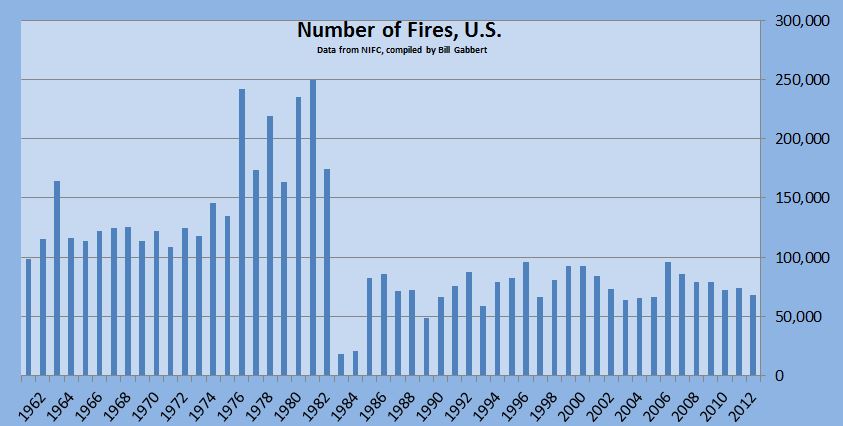Above: Junkins Fire, southwest of Pueblo, Colorado. Photo provided by the Incident Management Team on October 19, 2016.
There have been many discussions recently on this website, in the scientific community, and in the more public arena about why the number of acres burned in wildfires has been increasing rapidly over the last several decades. From the mid-1980s through 2015 the average number of acres burned has grown from about 2 million acres a year to around 8 million. Some people like to claim that this was caused by climate change, environmentalists preventing timber from being harvested, or other factors. However, to complicate the issue, some data appears to indicate that between 1920 and 1950, 10 million to 50 million acres burned each year.
It is very difficult to say that one factor caused fire occurrence to change. While comparing acres burned in the early part of the 20th century to what we are seeing in recent decades, many variables need to be considered:
–Weather and climate trends. This has been vigorously discussed in many venues.
–The capacity to suppress wildfires. In the first two-thirds of the 20th century the ability of land managers to suppress wildfires was very different from what we have today. Fire engines now carry many times more water, and transportation systems enable quicker initial attack response. Helicopters and air tankers were brought into the equation. Heavy equipment became more prolific and capable. More efficient communication and dispatch systems were created. Fires are detected more quickly. Firefighters are routinely brought in from hundreds or even thousands of miles away.
–The wildland-urban interface is growing. More people are living and recreating where previously there was less human activity. This can increase the number of fire starts, and the endangered structures often have an effect on the priorities of firefighters and where they are deployed, as opposed concentrating forces where they are most likely to contain the fire.
—Changes in how timber is managed and harvested.
–Fire suppression can result in longer fire return intervals and increases in the amount of fuel available for the next fire.
–Fuel treatments: mechanical and prescribed fire.
–Changes in the vegetation: non-native species, insects, disease.
–Accuracy of the fire occurrence data. Can the data for 1920 be compared with the data from 2016? The fire occurrence data at NIFC for 1962 through 2015 shows a huge swing beginning in 1983 and 1984, with the number of fires overnight dropping by about 50%, a trend that continued through 2015. This leads one to lose confidence in the data. One would think that the more modern era, post 1984, would have more accurate information than previous decades.
–Changes in wildfire management policy: full, limited, or no suppression.
Our readers will probably suggest even more factors that affect the number of fires and acres burned.
Considering all of these variables, I am skeptical of reports saying that just one is responsible for changes in the number fires and acres burned.


